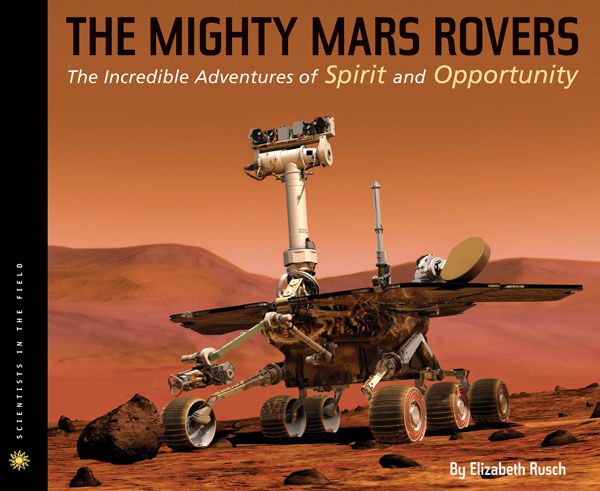
Series Scientists in the Field By Elizabeth Rusch
Hardcover edition
Publisher Houghton Mifflin Harcourt Imprint Houghton Mifflin ISBN9780547478814
Awards and Honors Kirkus Reviews Best Children’s Book of 2012; NSTA Outstanding Science Trade Books for Students K—12: 2013; SLJ Best Children’s Books 2012, Nonfiction; Booklist Top 10 Books for Youth 2012, Science & Health; 2013 NCTE Orbis Pictus Award for Outstanding Nonfiction for Children, Honor Book; ALSC 2013 Notable Children’s Books, Middle ReadersThe Mighty Mars Rovers: The Incredible Adventures of Spirit and Opportunity
 5
5
|
Standard MARC Records Cover Art |
Upper Elementary/Middle (Grades 5-7)
Upper Elementary/Middle
Upper Elementary/Middle (Grades 5-7)
For Grades 5-7
This 12-book collection provides the perfect literary mix for middle-grade readers, offering engaging novels and thought-provoking nonfiction. With multi-dimensional stories that captivate and challenge, these titles are sure to be in high demand! Some selections may explore identity, relationships, and real-world challenges, including LGBTQIA+ themes, moderate language, social issues, and other sensitive topics.
Interests
Chapter Books/Novels, Fiction, Reluctant Readers, Transitional Readers, Realistic Fiction
-
 The Wolves and Moose of Isle Royale: Restoring an Island Ecosystem
The Wolves and Moose of Isle Royale: Restoring an Island EcosystemNonfiction Middle Plus
August 2022
 21.6
21.6
-
 Beetle Busters: A Rogue Insect and the People Who Track It
Beetle Busters: A Rogue Insect and the People Who Track ItScience Nonfiction Elementary Plus
October 2014
 6.75
6.75
-
 Wild Horse Scientists
Wild Horse ScientistsUpper Elementary/Middle Plus
November 2012
POTENTIALLY SENSITIVE AREAS
Medical: Animal Anatomy/Reproduction
 5
5
-
 The Big One: The Cascadia Earthquakes and the Science of Saving Lives
The Big One: The Cascadia Earthquakes and the Science of Saving LivesNonfiction Middle Plus
August 2020
 12.5
12.5
-
 Saving the Tasmanian Devil: How Science is Helping the World's Largest Marsupial Carnivore Survive
Saving the Tasmanian Devil: How Science is Helping the World's Largest Marsupial Carnivore SurviveNonfiction Middle
August 2019
 6
6
-
 Mission to Pluto: The First Visit to an Ice Dwarf and the Kuiper Belt
Mission to Pluto: The First Visit to an Ice Dwarf and the Kuiper BeltNonfiction Middle
January 2017
 5
5
-
 Crow Smarts: Inside the Brain of the World’s Brightest Bird
Crow Smarts: Inside the Brain of the World’s Brightest BirdScience Nonfiction Elementary Plus
August 2016
 12
12
-
 Whaling Season: A Year in the Life of an Arctic Whale Scientist
Whaling Season: A Year in the Life of an Arctic Whale ScientistScience Nonfiction Elementary Plus
October 2009
POTENTIALLY SENSITIVE AREAS
Illustrations/Images: Blood/Gore
 5
5
-
 Saving the Ghost of the Mountain: An Expedition Among Snow Leopards in Mongolia
Saving the Ghost of the Mountain: An Expedition Among Snow Leopards in MongoliaNonfiction Middle
June 2009
 5
5
-
 Extreme Scientists: Exploring Nature’s Mysteries from Perilous Places
Extreme Scientists: Exploring Nature’s Mysteries from Perilous PlacesNonfiction Elementary Plus
May 2009
 5
5
-
 Science Warriors: The Battle Against Invasive Species
Science Warriors: The Battle Against Invasive SpeciesIntermediate Readers
October 2008
POTENTIALLY SENSITIVE AREAS
Language: Mild Language
 5
5
-
 Emi and the Rhino Scientist
Emi and the Rhino ScientistNonfiction Elementary Plus
Publication date not available
POTENTIALLY SENSITIVE AREAS
Medical: Reproductive/Sexual Reference/Discussion
 5
5
-
 Tracking Trash: Flotsam, Jetsam, and the Science of Ocean Motion
Tracking Trash: Flotsam, Jetsam, and the Science of Ocean MotionIntermediate Readers
Publication date not available
 9
9
-
 Quest for the Tree Kangaroo: An Expedition to the Cloud Forest of New Guinea
Quest for the Tree Kangaroo: An Expedition to the Cloud Forest of New GuineaNonfiction Elementary Plus
Publication date not available
 9
9
-
 The Prairie Builders: Reconstructing America’s Lost Grasslands
The Prairie Builders: Reconstructing America’s Lost GrasslandsIntermediate Readers Plus
Publication date not available
 5
5















